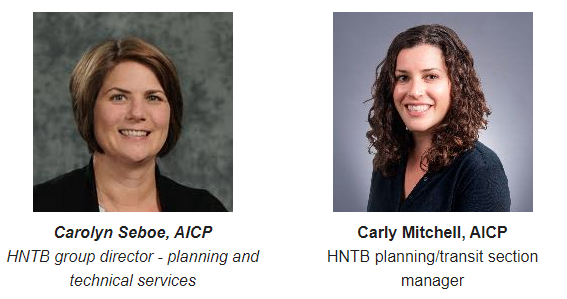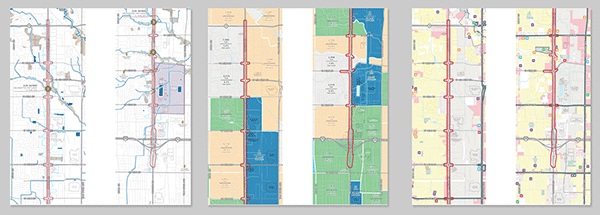Innovate Mound Newsletter – June 2020

The Innovate Mound newsletter is designed to keep you informed about the Innovate Mound project as it moves forward. Located in the cities of Warren and Sterling Heights, Macomb County, the project will reconstruct approximately nine miles of Mound Road between 11 Mile Road and M-59. We invite you to share this information with your friends, neighbors, employees, and 08constituents. We’d also like to hear from you—please contact us with your thoughts, ideas, questions, and concerns.

Innovate Mound proejct team members Nate Ford (left) and Carly Mitchell (middle) speak with an attendee of the Innovate Mound 101 event earlier this year.
Did Someone Say “Environmental”?
Environmental. We hear that word referred to often about everything from global warming to recycling. But what does “environmental” have to do with road construction? And why is it important to the Innovate Mound project?
Carolyn Seboe, AICP, HNTB group director – planning and technical services and Carly Mitchell, AICP, HNTB planning/transit section manager have answers to both questions. These planning professionals each have years of experience developing environmental studies for major infrastructure projects like Innovate Mound.
“Well, agencies like the Macomb County Department of Roads, or even the Michigan Department of Transportation, can’t just decide to reconstruct a road one day and start digging things up the next,” Seboe began.
“Major construction projects that get federal funding, like the INFRA grant Macomb County received for Mound Road, have to follow NEPA guidelines,” she said. “NEPA, the National Environmental Policy Act, says that agencies have to assess the potential environmental impacts of a proposed project before making final decisions on how to build it.”
“Within NEPA, there are different levels of evaluation depending on the complexity and impacts anticipated for a project,” added Mitchell. “For Mound Road, our team is developing what is called a Categorical Exclusion to access the potential social, economic, and environmental impacts of the project. This includes detailed studies on how reconstruction might influence the residential, business, historic, ecological, and physical environments along the corridor.”
The environmental team works closely with the public involvement team. Project planners attend public open houses and one-on-one meetings with individuals, organizations, and businesses within the project area. They also consider comments submitted to the project website. This important public input, along with data from their studies, is used to develop the environmental documentation and ultimately, the project design and construction.
“This process gives us confidence that we have a solid project based on strong public input that will have minimal impact on the corridor,” said Mitchell.
At this point, the biggest projected impact will be the temporary inconveniences caused by the construction process. This includes traffic slowdowns from lanes being reduced, temporary changes in access, and additional noise and dust.
The team began work on the Categorical Exclusion in late August 2019 and expects to receive approval from the Federal Highway Administration (FHWA), a division of the United States Department of Transportation, by the fall in order to move into the construction phase.
“Mound Road is a well-established corridor, which helps the environmental impacts to be minimal. We will communicate the findings to the community once the report is finalized. Though this is a lengthy and complex process, it ensures this project will stay true to the community once complete,” Seboe concluded.

What is an Environmental Analysis?
Macomb County, in coordination with the Federal Highway Administration (FHWA), is conducting an environmental analysis in accordance with the National Environmental Policy Act (NEPA) to evaluate the project’s potential impacts to the social, cultural, and natural environment. A Catergorical Exclusion (CE) is being prepared because the project is not expected to individually or cumulatively have a significant environmental impact.
What are the types of things that are evaluated in a Categorial Exclusion?
- Residential
- Business
- Environmental justice
- Threatened and endangered species
- Historic properties and districts
- Hazardous and toxic materials
- Section 4(f) and Section 6(f) properties
- Traffic
- Noise
- Air quality
- Wetlands
- Streams
- Water quality
- 100-year floodplain

You can view more information on the Environmental Analysis on our website.
Why Mound Road?
Q & A with Bryan Santo, Director, Macomb County Department of Roads
Q: What about the infrastructure and drains along the road in the project area?
A: Studies are being done in this pre-planning stage to assess the infrastructure needs in the project area so they can be addressed during the construction phase if necessary.
Q: What is being done about areas of Mound Road that flood during times of high precipitation?
A: Drainage capacities are being studied. Areas that don’t currently have adequate drainage capacity will be upgraded during construction.
Q: Is there anything going to be done to help with the noise that is generated from Mound Road?
A: A noise analysis will be completed as part of the preliminary planning and engineering of the Innovate Mound project. The noise analysis will follow the FHWA Highway Traffic Noise Analysis and Abatement Guidance to determine if abatement measures are feasible, reasonable and cost effective.
